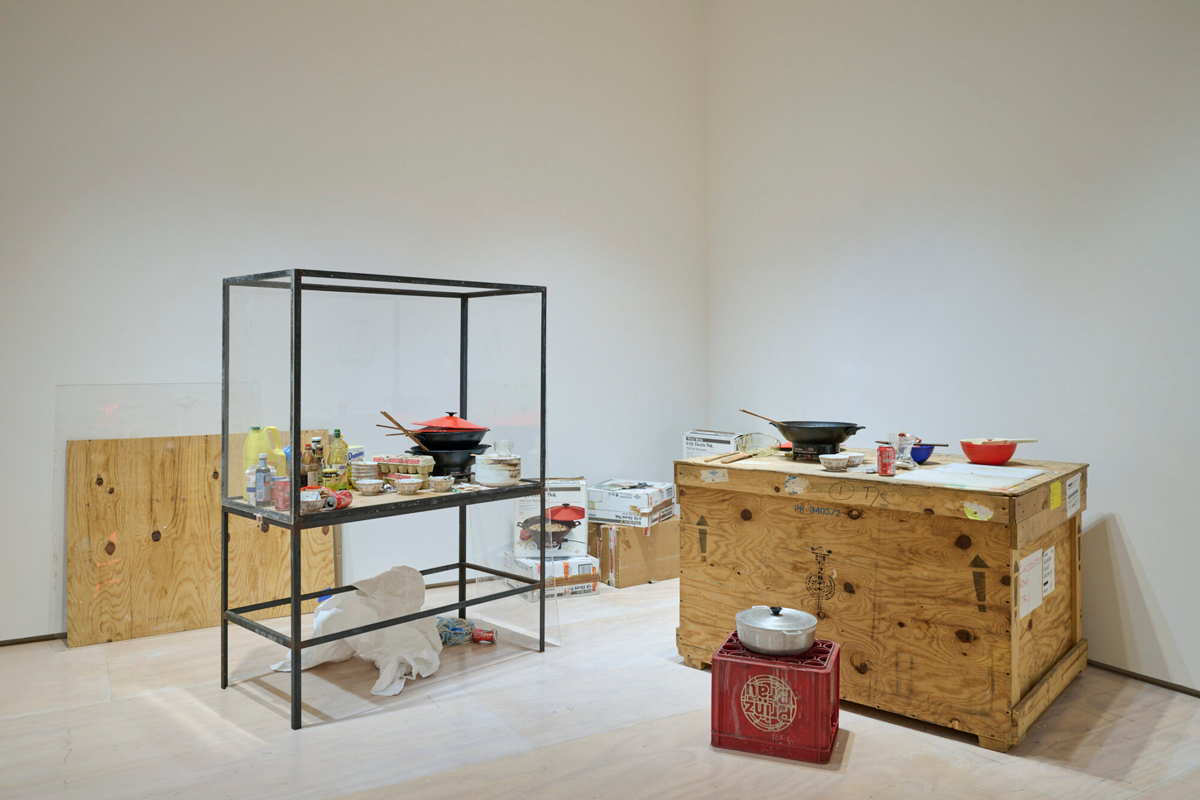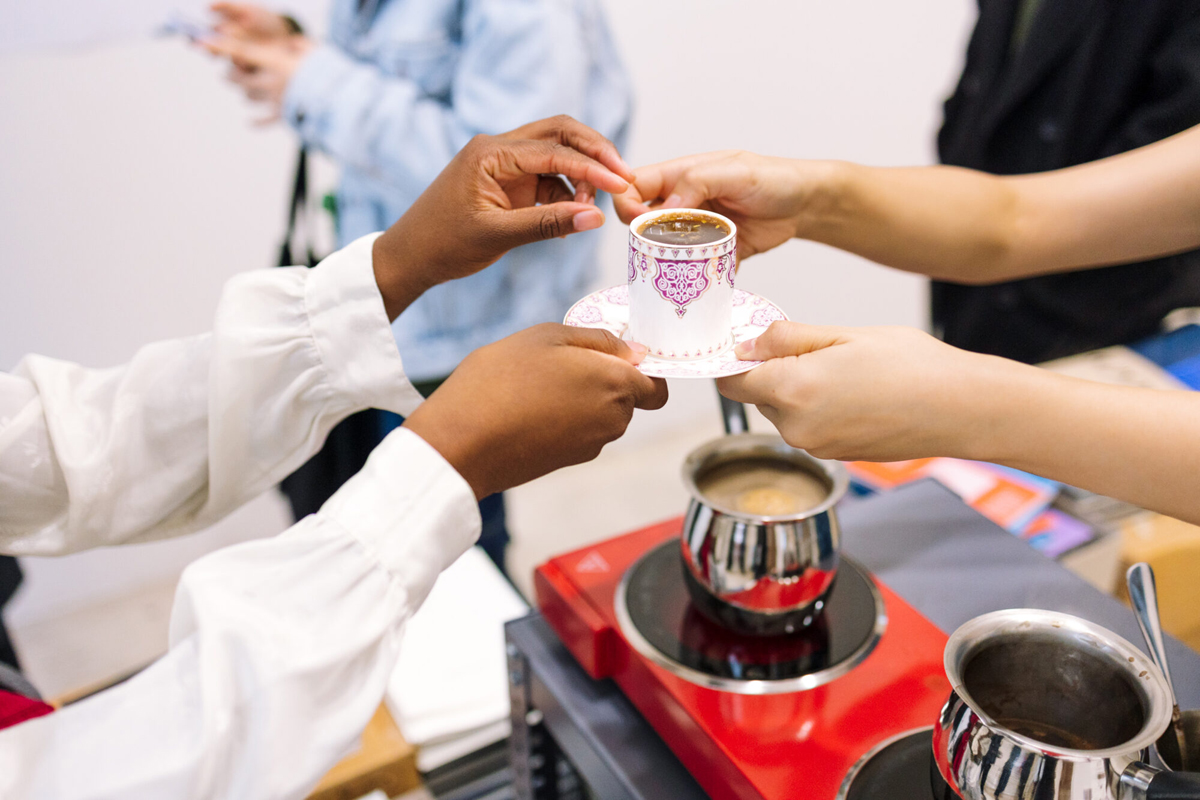 Alex Kitnick
Alex Kitnick
Pad thai for the people: forty years of shaking up the space of art.

Rirkrit Tiravanija: A LOT OF PEOPLE, installation view. Courtesy MoMA PS1. Photo: Kyle Knodell. Pictured: untitled 1990 (pad thai), 1990. Mixed media.
Rirkrit Tiravanija: A LOT OF PEOPLE, organized by Ruba Katrib and Yasmil Raymond with Jody Graf and Kari Rittenbach, MoMA PS1, 22–25 Jackson Avenue, Long Island City, New York, through March 4, 2023
• • •
Rirkrit Tiravanija is probably best known as the artist who cooks curry and gives it away for free. And this is not untrue. In 1992 he served bowls of the Thai dish at 303 Gallery in New York—and he has done so, in various locations, any number of times since. While his work, at least from this description, sounds like something that would have to be invented if it didn’t already exist, the way Tiravanija changes the space of art—transforming museums and galleries into third places, more like coffee or barber shops than chilly white cubes—has not been as frequently noted. When ambling through the artist’s installations, time and place become painfully key. If you weren’t at the opening, what you get—literally and metaphorically—is dirty dishes. And if you were there, you might have been only too aware of your participation and self-presentation. So, when Tiravanija calls his retrospective at MoMA PS1 A LOT OF PEOPLE, it’s clear how reliant he understands his work to be on its own reception—which is often, in fact, the work’s production. Without you, it’s nothing. Or at least it’s something else.

Rirkrit Tiravanija: A LOT OF PEOPLE, installation view. Courtesy MoMA PS1. Photo: Marissa Alper. Pictured: untitled 1993 (café deutschland), 1993 (detail). Four chairs, one table, metal shelves, stacked books, mixed media, Turkish coffee, and a lot of people.
Excitingly, there were a lot of people when I went to see the show on a rainy Saturday afternoon—and, though I didn’t run background checks, there appeared to be a lot of different kinds of people, too. There were swarms of children, mostly accompanied by adults. There were art kids, students and stylists alike. There were hip oldsters. There were guards. There were people speaking several languages. It was a polyglot crowd—an international zone—and somehow that felt right for an exhibition by a Thai artist, born in Argentina, currently living in Berlin, New York, and Chiang Mai. About a third of the visitors stood in some kind of line—waiting for Turkish coffee, waiting for pad thai, waiting for tea (in other words, waiting to interact with artwork). Another third were sprawled across carpeted ramps and on wooden benches, watching lengthy videos of a retired rice farmer and bygone road trips—one shot by the artist as a traveling student, the other taken with Thai students in a motor home across the US. A number of folks were bunched around sculptural assemblages, peering at pots and pans, staring at stereos, fondling books. One person was banging away at a drum kit, forging a loud steady beat. (A pang of envy cut through my relatively beatless body.) It was, I imagined, what an all-ages after-school program might look like in a social democracy—and while some critics have slammed Tiravanija for making work that’s too easygoing, that doesn’t bring society’s divisions into full relief, on a gray day, with so many bombs dropping on so many places, it all felt more than totally okay. In fact, it felt pretty great.

Rirkrit Tiravanija: A LOT OF PEOPLE, installation view. Courtesy MoMA PS1. Photo: Marissa Alper. Pictured: untitled 1990 (pad thai), 1990. Ingredients for pad thai, utensils, electric woks, and a lot of people.
But there is also a whole other half of the exhibition that is stranger and quieter. (In other words, it is more like art.) Call these the relic rooms. Or the reformatting rooms—because the things there are not simply left over from older projects (though sometimes they are) as much as they are renovated and rejiggered. (They’re also soaked in art history.) There’s a row of metallic urinals hung on the wall, a shiny doppelgänger of the men’s room at the defunct New York punk club CBGB. (I thought of Marcel Duchamp.) There are stacked crates of what look like empty beer bottles that are actually cast resin. (I thought of Jasper Johns.) There is an endless column of sealed rubbish bins—one atop the other—time capsules from an exhibition thirty years ago. (I thought of Constantin Brâncuși.) There is also a video of a bronze-cast tire, covered in petroleum and set on fire, rolling through a room with a reflective floor and a host of replica wheels—a nod to 2010 anti-military protests in Thailand. (I thought of Allan Kaprow.) But perhaps the signal object is a large wooden crate containing hours of mini-cassette recordings that no one can listen to until after the artist’s death. (Again, I thought of Duchamp, but also Robert Morris—I guess I was thinking a lot about men.) I found all these things inscrutable, and yet they had a richness to them. Reeking of social life, they seemed somehow more than heirlooms; more than art history shout-outs, too. I was curious about what had happened around these things—and while I felt a bit of frustration that I’d never find out, it seemed more important that the meanings of these artworks belonged to those who made them. Not everything can be communicated or represented, after all (maybe that’s what makes things special), and while the experiences that formed these works can’t be reconstructed, their traces can be translated, picked up again, and versioned into something new.

Rirkrit Tiravanija: A LOT OF PEOPLE, installation view. Courtesy MoMA PS1. Photo: Kyle Knodell. Pictured: untitled 2015 (bangkok boogie woogie, no. 2), 2015. Sixteen bronze tires, acrylic paint, copper sheets, and single-channel HD video (color, sound), 6 minutes 23 seconds.
If Tiravanija’s most celebrated work emphasizes activity and its aftermath, the artist’s practice is, at root, future forward, tied to questions of pleasure, politics, and possibility. In the art world, Tiravanija is widely known for a roving project called Utopia Station, undertaken in 2003 with the art historian Molly Nesbit and the curator Hans Ulrich Obrist, which offered ad-hoc workshops for a world to come. Tiravanija’s own project stems from a similar insight: utopia is always in front of us; this is just throwing spaghetti at the wall. And yet something of the artist’s idealistic spirit has been obscured in recent years, as he has become increasingly involved with what can only be called merch art—newspaper-paintings and T-shirts printed with a recognizable font and slightly garbled liberal commonplaces—that, while not any crime against humanity, doesn’t rise much above the aesthetic level of a fairly decent tote.

Rirkrit Tiravanija: A LOT OF PEOPLE, installation view. Courtesy MoMA PS1. Photo: Kyle Knodell. Pictured, foreground: untitled 2021 (mañana es la cuestión), 2021. Silkscreen on ping-pong table and paddles. Back wall: U.F.O. – NAUT JK (Július Koller), 2012. Digital print.
So a big smile ripped across my face when I saw a tiny oil painting—one of only a few in the show—reading LESS OIL MORE COURAGE. Here, in oil paint, with tongue in cheek, Tiravanija makes clear what he has been chipping away at all along—not simply the West’s cruel fossil-fuel fetish (I imagine the artist’s own carbon footprint is bigger than a clown’s shoe), but the art world’s complacency not only with painting—and painting again—but with business as usual (buy, sell, fist bump). I myself usually advocate for the conventional when it comes to art—it seems to me the best way to get messages across—but Tiravanija’s trip, an almost forty-year headlong plunge into the mess of contemporary life via cooking, convening, traveling, and teaching, felt truly courageous on a dreary Saturday in October 2023. Even works of his that might be too ingratiating—a functional ping-pong table emblazoned with the statement MAÑANA ES LA CUESTIÓN (Tomorrow Is the Problem)—seemed pertinent when seen from above. (There was a line, so I gazed upon the work from the mezzanine.) Playing ping-pong today is all well and good, in other words, but what is to be done tomorrow? The answer was not to be found in a cup of tea, or in a bowl of curry, but in a massive photograph of people gathered in a public plaza, organized in the form of a question mark.
Alex Kitnick teaches art history at Bard College in Annandale-on-Hudson, New York.